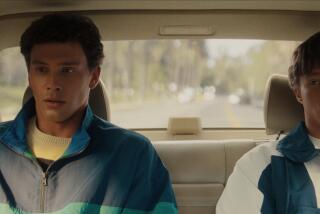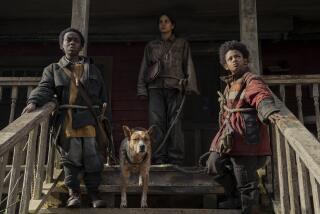COMMENTARY : Frightening Messages From the Movies : ‘The Accused’ and ‘Halloween 4,’ Though Wildly Different, Have Something Disturbingly in Common
What do “The Accused” and “Halloween 4” have in common? At first glance, it might seem like straining to compare the tony cinematic anti-rape tract--with its high-rent stars Jodie Foster as working-class victim and Kelly McGillis as doughty prosecutor--to the latest scream-yourself-hoarse installment of the Oct. 31 exploitation series.
“Halloween 4” has few big-name stars--just the perennial Donald Pleasence playing
the lugubrious psychiatrist-keeper of homicidal Michael Myers and a gaggle of limber females playing teen-aged residents/victims of Haddonfield, Ill., each undoubtedly hoping to be the next Jamie Lee Curtis, who was terrified so fetchingly in the original “Halloween” of 1978 and a sequel before going on to bigger things.
Both “The Accused” and “Halloween 4” are movies with messages. But the message in “Halloween 4” seems frivolous when compared to that of “Accused.” In “Accused,” the message crawls didactically across the screen just before the end credits (in case we didn’t get it earlier): “In the United States a rape is reported every six minutes.” In “Halloween 4,” the message comes right at the beginning: “The Return of Michael Myers.”
“The Accused” and “Halloween 4” contain key scenes set in virtually identical-looking blue-collar bars, the kind with pinball machines, loud music, a paucity of female customers and a great many snap-brim types sitting solo on the stools nursing beers.
But the Mill, the roadhouse in “Accused,” is a sinister dive where all leering eyes fasten ominously on Jodie Foster as the imprudent Sarah Tobias, who makes the tactical mistake of entering unescorted clad in a hip-length denim skirt and high heels. She has a few too many and performs an alluring dance in front of one of the friskier bar denizens. He promptly throws her atop a pinball machine and rapes her, followed by two others, while the brutish all-male crowd cheers the trio on, shouting, “Hold her down!”
This lurid scene is the high point of the movie. Had it been edited out by director Jonathan Kaplan, the audience for “Accused” would be small indeed.
By contrast, the worst sin of the denizens of the workingmen’s bar in “Halloween 4” seems to be membership in the National Rifle Assn. These chivalrous if misguided souls grab their shotguns and their pickups and head off on a vigilante hunt for Michael Myers, gunning down one of their neighbors by mistake in a humorous episode. When they later encounter Michael, whose strength and cunning are superhuman, the outcome is highly unpleasant. “You can’t kill evil--it never dies,” comments Pleasence as Dr. Loomis. He knows his escaped patient all too well.
Different as they may be, “The Accused” and “Halloween 4” are both end-products of our society’s efforts to ban or neutralize two powerful human phenomena: male aggression and religion.
These days, it is as unfashionable in enlightened circles to lionize masculine attitudes and virtues (we mock that kind of behavior with the epithet macho ) as it is to carry a Bible. When those phenomena are officially suppressed, interest in them does not die. It continues, but in crude underground form.
For the audience, the appeal of “Accused” is, quite frankly, the appeal of watching the rape scene, filmed in excruciating length and detail. This is partly the fault of the makers of the movie. They could have focused more carefully on the jury trial. Prosecutor Katheryn Murphy, played by McGillis, takes plea bargains on reduced charges from the three rapists, then regrets her decision and decides to put their barroom spectators on trial for soliciting and encouraging a felony. This is a dicey, hard-to-prove legal theory and provides food for drama. But the trial in “The Accused” is shown in truncated form, with much of the testimony off screen and unpersuasive arguments from the lawyers.
Rape is, of course, male aggression run criminally amok. But “Accused” does not stop at rape. In a script that could have been written by Shere Hite, the film launches a relentless, hectoring attack on every form of male behavior and male character type.
One of the three perpetrators is a clean-cut college fraternity man; that brings date rape, a fashionable campus sensitivity-group topic these days, under the movie’s didactic umbrella. There are the brutish onlookers, who bully their wives and smirk and leer even when they are on trial facing prison sentences.
Sarah’s boyfriend is a biker, and we might expect him to go after her attackers with a length of lead pipe. But no--he is as affectless as Michael Dukakis was when he was asked during the debates if he’d support the death penalty if his wife Kitty were raped and killed. Katheryn’s colleagues at the district attorney’s office, where she is the only woman, are a derriere-covering old boys’ network who try their best to squelch the ticklish prosecution. In one scene, all the D.A.s go off to the hockey rink to guzzle beer while the players bash each other with their sticks. Get the symbolism?
“The Accused” is a top grosser, and there have been reports that men are going to the film just to cheer during Jodie Foster’s protracted on-screen violation. There were no cheers at the matinee I attended. But there were plenty of young men there without dates, including a quartet of teen-agers who argued the legal issues afterward and concluded they would have voted “not guilty” (prosecutor Murphy would not have wanted these fellows on her jury).
This perverse reaction is natural. Banished to the sidelines, supposedly legislated out of existence as men and women learn to be more androgynous, male aggression reemerges as a subject of prurient interest. The makers of “The Accused” see no positive role for masculinity--in such manifestations as courage, protectiveness toward the weak (including women), or a gentlemanly willingness to take “no” for an answer. They paint the male as entirely evil--then get seduced by the very glamour of evil that “The Accused” is supposed to be shaking its finger at.
“Halloween 4,” like other horror movies, trades on the underground persistence of such religious concepts as sin, hell, damnation and the devil--concepts that many sophisticated people have decided just don’t exist anymore. We live in an age in which it is considered unhealthy to feel guilty about anything, and we reject the idea of a God who never says no, much less metes out punishment for disobeying His rules.
Specifically, horror movies trade on the underground persistence of Christianity, the traditional variety of Christianity derided as “fundamentalist” (most other religions have moral codes and sanctions for disobedience, but none so palpably as traditional Christianity.
We enlightened denizens of the late 20th Century are like Lady Macbeth, who scoffs: “Tis the eye of childhood that fears a painted evil.” Horror movies play on our sneaking nightmare suspicion that the painted evil may be out there seeking the ruin of souls; that death, instead of pleasant annihilation, may be the beginning of eternal disquiet.
Just as male aggression takes on a melodramatic cast in “Accused,” the Christianity in horror movies is of a highly melodramatic variety, with the devil seemingly besting God himself in Manichean conflicts.
“I believe the Bible,” reads a bumper sticker pasted inside a talkative traveling preacher’s car in “Halloween 4,” as Dr. Loomis hitches a ride in an effort to warn Haddonfield residents about Michael’s escape and imminent arrival.
The preacher is the spiritual heir of the Catholic priests in the “Exorcist” movies who struggle to purge Satan from his victims. At home in Haddonfield, 7-year-old Jamie, Michael’s little niece (big Jamie Lee Curtis played her mother, an earlier Myers murder victim), says her prayers before going to bed while her teen-age foster sister, Rachel, is protective.
This is a movie where sin has consequences. Rachel’s boyfriend, Brad, strays into the carnal embrace of a busty female classmate; both pay gruesomely with their lives. Only Rachel, chaste, loving and courageous, survives. But Myers, like Satan, has an unearthly facility for overpowering even the innocent.
“Halloween 4” sets the stage for a “Halloween 5,” and there is likely to be such a sequel and many more movies of its ilk. There also seems to be an audience for the illicit thrills of nefarious but photogenic male perfidy, as in “The Accused.”
There is a lesson to be learned here: We are on a campaign to banish from contemporary life the irrational, the passionate and the risky. It keeps returning to our popular arts in perverse form.
More to Read
Only good movies
Get the Indie Focus newsletter, Mark Olsen's weekly guide to the world of cinema.
You may occasionally receive promotional content from the Los Angeles Times.










